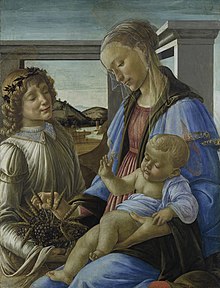
Alessandro di Mariano di Vanni Filipepi, better known as Sandro Botticelli or simply Botticelli, was an Italian painter of the Early Renaissance. Botticelli's posthumous reputation suffered until the late 19th century, when he was rediscovered by the Pre-Raphaelites who stimulated a reappraisal of his work. Since then, his paintings have been seen to represent the linear grace of late Italian Gothic and some Early Renaissance painting, even though they date from the latter half of the Italian Renaissance period.

Filippino Lippi was an Italian painter working in Florence, Italy during the later years of the Early Renaissance and first few years of the High Renaissance.

The Isabella Stewart Gardner Museum is an art museum in Boston, Massachusetts, which houses significant examples of European, Asian, and American art. Its collection includes paintings, sculpture, tapestries, and decorative arts. It was founded by Isabella Stewart Gardner, whose will called for her art collection to be permanently exhibited "for the education and enjoyment of the public forever."

Filippo Lippi, also known as Lippo Lippi, was an Italian painter of the Quattrocento and a Carmelite priest. He was an early Renaissance master of a painting workshop, who taught many painters. Sandro Botticelli and Francesco di Pesello were among his most distinguished pupils. His son, Filippino Lippi, also studied under him and assisted in some late works.

The Tragedy of Lucretia is a tempera and oil painting on a wood cassone or spalliera panel by the Italian Renaissance master Sandro Botticelli, painted between 1496 and 1504. Known less formally as the Botticelli Lucretia, it is housed in the Isabella Stewart Gardner Museum of Boston, Massachusetts, having been owned by Isabella Stewart Gardner in her lifetime.
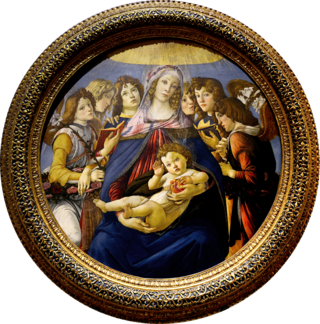
The Madonna of the Pomegranate was painted in circa 1487 with tempera on a wood panel by Sandro Botticelli. It is now in the Uffizi in Florence. Sandro Botticelli was a leading Italian Renaissance artist from Florence, Italy. The Madonna (art) uses the circular format, better known as a tondo, which focuses the attention on the main characters, the Virgin Mary and baby Jesus, who are surrounded symmetrically by angels on each side. Botticelli's use of tempera grassa give the characters a real look, better known as a "naturalistic" style, which is common during the Renaissance. The Virgin Mary is holding baby Jesus gently in her arms while holding a pomegranate in her left hand.

The Madonna of the Book, or the Madonna del Libro, is a small painting by the Italian Renaissance artist Sandro Botticelli, and is preserved in the Poldi Pezzoli Museum in Milan. The painting is executed in tempera on panel. It dates from between 1480 and 1481.

Madonna in Glory with Seraphim is a painting by the Italian Renaissance painter Sandro Botticelli, executed c. 1469–1470. It is housed in Galleria degli Uffizi.

The Virgin and Child with Two Angels is a painting by the Italian Renaissance master Sandro Botticelli, dating to c. 1468–1469. It is in the Museo Nazionale di Capodimonte, in Naples.
The decade of the 1460s in art involved some significant events.

The Madonna and Child with Three Angels is a painting by the Italian Renaissance master Sandro Botticelli, executed around 1493. It is housed in the Pinacoteca Ambrosiana of Milan.
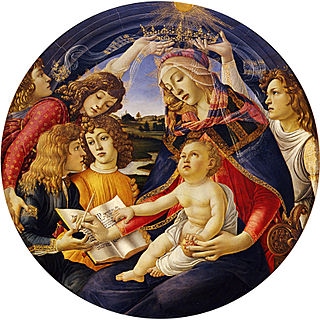
The Madonna of the Magnificat, is a painting of circular or tondo form by the Italian Renaissance painter Sandro Botticelli. It is also referred to as the Virgin and Child with Five Angels. In the tondo, we see the Virgin Mary writing the Magnificat with her right hand, with a pomegranate in her left, as two angels crown her with the Christ child on her lap. It is now in the galleries of the Uffizi, in Florence.

The Madonna and Child with Six Saints, also known as Sant'Ambrogio Altarpiece, is a painting by the Italian Renaissance master Sandro Botticelli, finished around 1470. It is housed in the Galleria degli Uffizi, in Florence.

Madonna Adoring the Child with Five Angels is a tondo or round painting by the Italian Renaissance master Sandro Botticelli, completed between 1485 and 1490. It is housed in the Baltimore Museum of Art, in Baltimore, Maryland. The medium is tempura and oil on a round wood panel. It is part of the Mary Frick Jacobs Collection.
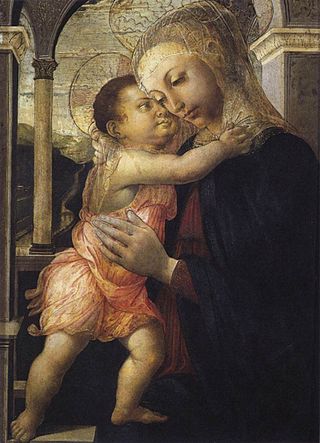
The Madonna della Loggia is a painting attributed to the Italian Renaissance artist Sandro Botticelli, dating to c. 1467. A tempera on panel work, it is located in the loggia of Uffizi, Florence, Italy.
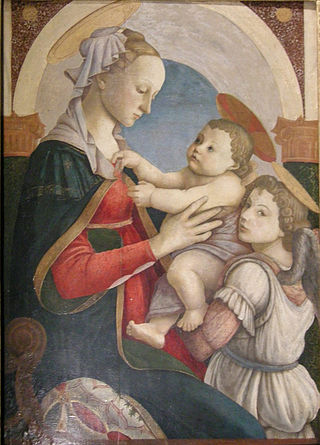
The Madonna and Child with an Angel is a painting by the Italian Renaissance painter Sandro Botticelli, c. 1465–1467. It is housed in Spedale degli Innocenti of Florence.

The Virgin and Child with Two Angels is a painting by the Italian Renaissance painter Andrea del Verrocchio, dating from circa 1467–1469. It is in the National Gallery, London, United Kingdom.

Madonna with Child is a painting by the Italian Renaissance artist Filippo Lippi. The date in which it was executed is unknown, but most art historians agree that it was painted during the last part of Lippi's career, between 1450 and 1465. It is one of the few works by Lippi which was not executed with the help of his workshop and was an influential model for later depictions of the Madonna and Child, including those by Sandro Botticelli. The painting is housed in the Uffizi Gallery, Florence, Italy, and is therefore commonly called “The Uffizi Madonna” among art historians.
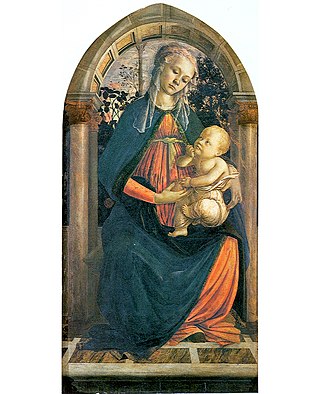
The Madonna of the Rose Garden is a tempera on panel painting made by Sandro Botticelli, whose date of between 1469 and 1470 makes it one of his earliest paintings. It is now in the Uffizi Gallery in Florence, Italy.
